Project: Rosemont College Reconnects with Young Alumni
Vertical Market: Education
Business Application: Direct Marketing/Lead Generation/Loyalty
Business Objectives
Rosemont College is a small private liberal arts college located in Philadelphia, Pennsylvania. Rosemont felt that they did not have a strong connection with young alumni who had graduated within the past 10 years. The college felt it was important to start building relationships with this group of alumni now. By growing young alumni’s connections with Rosemont, the college hoped that they could then be encouraged to become supporting donors.
Rosemont also wanted to strengthen relationships with alumni as it transitioned from being a women’s college to a co-ed institution.
- Re-engage young alumni prior to asking them for gifts to Rosemont’s Annual Fund
- Cleanse existing data and capture new information from alumni
- Secondary goal was to collect donations
Campaign Architecture
To address the needs of Rosemont College, our associated company developed a three-phase cross-media campaign.
Phase One
This focused on reconnecting with the alumni in order to cleanse the existing database and add new email addresses and profile information in preparation for future communication initiatives. An email and a direct mail piece were sent simultaneously in November encouraging recipients to visit their personalized landing page and share with Rosemont what they had been doing since graduation. The direct mail and email were personalized with the alumna’s name, graduation year, major and PURL.
A few weeks later a follow-up email was sent to individuals who had not responded.
At the personalized landing page alumni were asked to update their contact information and complete an online survey about their activities since graduation. As part of the survey Rosemont also learned:
- Preferred time of year for a reunion
- Favorite types of alumni events
- Likelihood of attending a future alumni event
- Willingness to host a future alumni event
At the personalized landing page alumni were also encouraged to reconnect with peers using the Rosemont Alumni Facebook page.
Phase Two
The responses were analyzed, and a second round of communication was sent to alumni in December sharing news about each class. This was accomplished through email and direct mail. The goal in this phase was to continue to build the relationship with alumni who responded and to give those who had not responded to Phase 1 another opportunity to participate.
Information that was shared included:
- Participation by class year
- Percentage of class that went on to graduate school, were single, had children, or who were volunteering in the community
- Class preference for when to hold a reunion
Those who had not responded to Phase 1 were again given a PURL to visit where they could participate in the survey.
Phase Three
This was the first appeal for donation and was sent to young alumni in March via email and direct mail. Recipients were encouraged to visit their PURL and make a donation to support Rosemont College. The direct mail piece was personalized with available information on scholarships received and extracurricular activities participated in.
Rosemont wanted to determine if this level of personalization would have an effect on response rates before investing resources on compiling more data in this area. Mailers that included the extracurricular element saw a 24% response rate vs. a 17% response rate for those that did not include this information.
Target Audience
The target audience for this campaign was young alumni who graduated within the last 10 years.
The copy in the direct mail and emails for Phase 1 and 2 focused on reconnecting the college with alumni and enabling alumni to reconnect with each other. Similar messaging was used in the Rosemont Alumni Newsletter, website and Facebook pages creating consistency across all media used by the college to communicate with alumni.
In Phase 3 the messaging highlighted the financial need of Rosemont College and its current students given the difficult economy. Alumni were encouraged to recognize the benefits they had received as students and give a donation so that other students could receive a Rosemont education.
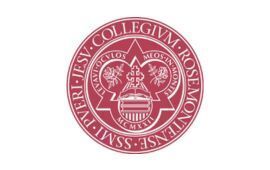
Results
- 23% response rate (alumni visited their personal URL)
- 85% conversion rate (completed survey on personalized landing page)
- 18% of young alumni provided new contact information
- Emails garnered as high as a 64% response rate
- 54 people (or 26% of the respondents) joined Rosemont's Alumni Facebook page
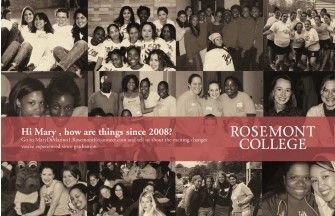
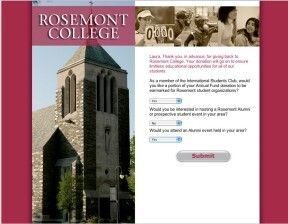

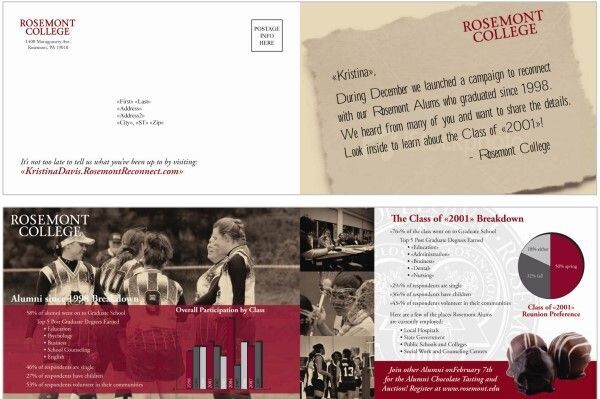
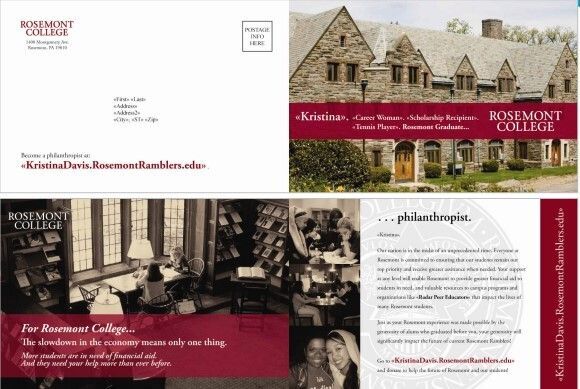
Best Practices Learned
- Build a relationship before asking for money. Rosemont College realized that it needed to have a deeper connection with its young alumni. While this age group may not be strong contributors now, it is important to cultivate them as future donors. That is why the first few communication pieces focused on reconnecting as opposed to making a hard push for money. After re-engaging with the alumni, Rosemont sent an appeal for donations. By getting these alumni in the habit of giving now, it is hoped that they will continue to give and increase their donation amounts as their earning potential grows.
- Connect with your audience in their preferred format. One of the factors that made this program a success was the PURL response mechanism. Going online to interact with friends and organizations is something 20 to 30 year-olds are very comfortable with. Using a PURL with the recipient’s name as part of the URL attracted attention and made responding very easy.
- Timing is critical. The communications for Phase 1 and Phase 2 of this campaign were sent out in late November and December. During the holiday season people are often connecting with old friends. Rosemont College was able to tie into this sentiment with the timing of their reconnect campaign.
